- Article tells about the dance performances, with
deeper meaning, on day two and three of the Khajuraho Dance Festival 2021.
In part One of Khajuraho Dance Festival 2021 I told you how day one of the festival took the audience on an enchanting journey from real to surreal... Read about day two and three.
One of
the most anticipated cultural events of India, the Khajuraho Dance Festival is
known to highlight the richness of Indian classical dance styles to include
Odissi, Kathak, Bharatnatyam, Mohiniattam and Kuchipudi, and Nritya Natya
presentations. This year after 47 years since the time of its inception in
1952, the festival was again held inside the temple premises. The festival saw
exotic presentations across dance forms displaying Abhinaya, Natya and Bhav at
its best.
The Odissi exponent Padmashri Aruna Mohanty is known for her hypnotic Abhinaya wherein her choreographies bestow a distinct precision along with aesthetic and dramatic sensibilities. This year she presented yet another marvellous production the 'Sansara' with her group.
Sansara depicted the various stages of
life from childhood, youth to old age, taking the onlookers to the realisation
of the ultimate truth of one merging with God, in front of the grand temples.
The act conveys the message that if we accept the youth (Jovana) so gracefully, we have to accept old age (Jara), and death (Mrityu) which is the final stage of our present life cycle.
Endowed
with graceful movements the act begins with the portrayal of an infant girl
crawling to her mother, while the mother embraces and plays with her depicting
the Vatsalya Srinagar Bhava. In the
next stage, the little girl is seen playing with her sakhis, while they tease her playfully. Eventually, she grows into
a beautiful maiden and realises the feeling of love when she meets her beloved
along with her sakhis.
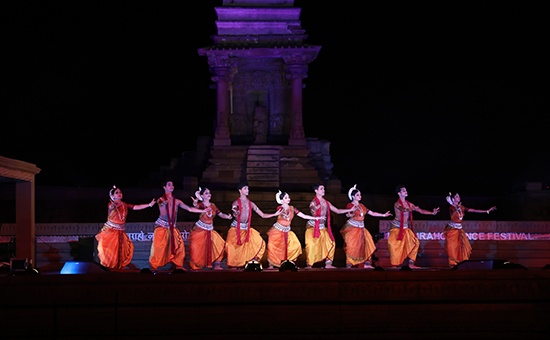 Aruna Mohanty Troup.
Aruna Mohanty Troup.
They play
and dance together as Radha and Krishna. Finally they embrace each other and
get involved in the worldly affairs leading the life of a Grahast. With their elegant movements,
subtle gestures, and attractive poses, the dancers portray the Sringara bhav. The
time passes and she comes to her old age when all the playfulness vanishes, she
feels distressed as her body is now old and tired, and one day finally her soul
rests in peace leaving the body.
The
enlightened soul finally realises that the only way to liberate oneself is to
praise the lord with Bhaj Govindam. The act was indeed an emotional journey with compellingly expressive abhinaya demonstrated with utmost grace, clarity, style and subtlety which define Mohanty's style transmitting a magical experience to the audiences.
 Ki Naad Re performance.
Ki Naad Re performance.
Her second
presentation Ki Naad Re depicted the scene of the Maharas as Krishna's flute enthrals the Gopis and mesmerises Radha. No one is spared with the sound of his flute, effecting the trees which start swinging, the flowers bloom while the deers, peacocks and birds all start dancing to its melody. In his absence Radha reminisces Krishna and feels miserable and sad depicting the Virha
Srinagar Bhava as everything seemed still to her. She wonders why his
flute still resonates in her mind, and at the very instant everything becomes
alive as she feels a deep love for him.
One could
notice beautiful sync of the bodies with the rhythm, emitting a dramatic power
rarely seen keeping the very dimension of the aesthetics of Odissi as a form,
its traditional poetry and repertoire.
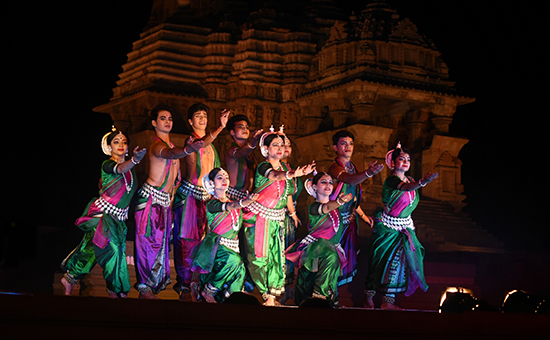 Nari Nirbhaya performance.
Nari Nirbhaya performance.
Her last presentation 'Nari Nirbhaya' took its inspiration from Devi Jagdamba of Khajuraho depicting the Shakti Roopinis of India from Sita in Ramayana, Draupadi in Mahabharata and Nirbhaya the daughter of India and depicted the saga of their love, agony, revenge and courage. The act was indeed a tribute to women’s struggle to live life with dignity.
The act begins with Ram Banvas and Sita's abduction by Ravana and how she is asked to prove her purity with the 'Agni Pariksha'. Draupadi questions Duryodhaa why she suffered this humiliation and promises to avenge her humiliation with his blood, which was well depicted with strong aggressive movements over the strong beats of a Nagada, to depict the beginning of a war of justice.
Again, Nirbhaya says despite all the struggle and humiliation and whatever I have suffered as a woman, I'll come victorious. I'm unconquered, undefeated and unthreatened and dare to face it, which is well depicted with the poetry Mo Ajaya, Mo Vijaya, Mo Nirbhaya.
The act
concluded with Ya Devi Surva Bhooteshu,
bringing forth a strong message that India is the land where women are compared
to a Devi, and this deterioration of our traditional values has to be stopped.
Indeed a masterpiece in itself wherein such a sensitive subject was depicted
with utmost dignity and grace, yet with powerful execution.
 Marg Natya performance by Piyal B Group.
Marg Natya performance by Piyal B Group.
Another outstanding piece of work was presented by Piyal Bhattacharya, a recipient of the Sangeet Natak Academy fellowship for his iconic research and reconstruction of the Natya repertoire as mentioned by Bharat Muni in Natya Shastra. The presentation 'Marg Natya' indeed gave a peep into the Natya of Bharata and its authentic format
bringing to light the ancient Indian tradition of Nritya, Geet and Abhinaya. The core texts of Natyashastra
and Abhinav Bharati and the commentary by Acharya Abhinav Gupta on Natyashastra
have been the key source of its research done over 18 years.
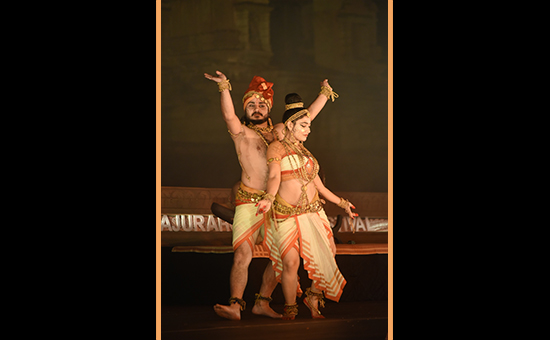 Marg Natya performance by Piyal B Group.
Marg Natya performance by Piyal B Group.
Presented in Sanskrit, Marg Natya is stylised according to the Natya Shastra with costumes like Kanchuki and Dhoti worn by the female dancers along
with the ancient ornaments and make-up. The musical instruments, props and
dance choreography has been followed as mentioned in the scripture, which
incidentally matched well with the sculptures of Khajuraho. The act was a befitting
tribute to the marvellous monuments of Khajuraho. In fact the dance recreated
the magic of an earlier era, displaying a deep understanding of the aesthetics
of this dramatic art form.
The first presentation 'Chitra-Purva-Ranga' as
described in Natyashastra is derived from the word Chitra-Purva which means 'Extraordinary. The act is indeed an extraordinary combination of dance and music, combined in a ritual, which is a symbolic expression of the cosmic creation. Ashwani vidhi the first part of
Chitra-Purva-Ranga commences with Trisama
a systematic playing of traditional instruments Tripushkara, Mahaghatka, Angika and Alinga used for the gradual invocation of Agni. The choreography
depicted a cluster of moving cosmic bodies during manifestation with subtle
movements.
One by
one the Natis or female dancers
performed and exited, and thereafter all four came in they performed the Pindibandhas group formations. The
female dancers gracefully performed the specific Lasyangas and Angaharas,
while the male performers and the Sutradhar performed the Charis as described in the Natyashastra.
The next presentation was 'Uproopaka Bhanaka'
focusing on Rasa Abhinaya and Bhava Abhivyakti wherein Bhanaka is a
male-dominated dance form that is believed to be originated from the Shaivait
tradition as mentioned in Natya Shastra.
The last part included the 'Kapalageeti' which
depicted the correlation of the Sapta
Swaras i.e. the seven notes, which invoke the seven dimensions of Shiva which further correspond to the 'Sapta Chakras' in the human body.
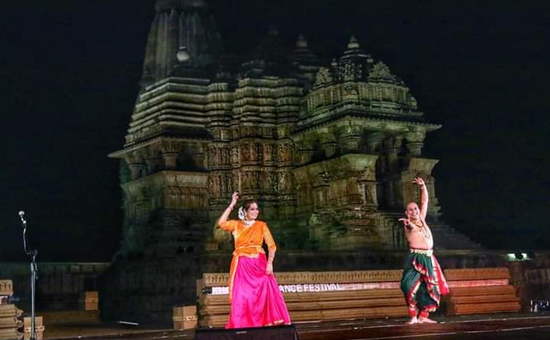 Sulagna and Rajdeep Banerjee performance.
Sulagna and Rajdeep Banerjee performance.
The festival also brought to the fore fusion of genres to include a Kathak and Bharatnatyam Amalgamation (Jugalbandi) by the Kathak exponent Sulagna Banerjee with Bharatnatyam exponent Rajdeep Banerjee who performed the 'Ardhnareshwa'. This is a combination of the female and male energy of Shiva & Parwati. The act was an ideal tribute to be performed in front of the Kandariya Mahadev and Devi Jagadamba temples.
Befittingly
depicting the Kavya Ardha bhaal chandran
laptaye, Ardha bhaal sindoor suhaye, Ardha
bhuja par damaroo baje, Ardha bhuja par kangan saje Sulagna depicted the
lasya rupa of Parwati with delicate, graceful movements of Kathak showcasing
the Shringara Bhava while Rajdeep
depicted Tandav rupa of Shiva with a
set of vigorous, powerful, sharp dance movements with strong body
projection characteristic of the Bharatnatyam style, symbolizing the
cosmic cycles of creation, preservation, and destruction thus depicting the Rudra rasa.
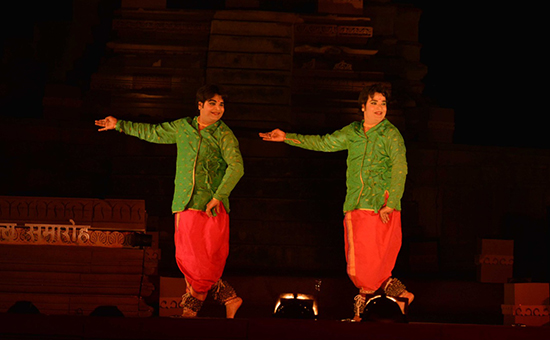 Saurabh and Gaurav, duet Kathak.
Saurabh and Gaurav, duet Kathak.
The
festival this year was a platform to showcase both seasoned and amateur
talents.
Young kathak dancers Saurabh and Gaurav Mishra presented a Kathak duet. Disciples of Pandit Ravi Shankar Mishra of Benaras Gharana, they are also learning the intricacies of the dance form, from the legendary Kathak exponent of Lucknow Gharana Pandit Birju Maharaj through his workshops.
They presented 'Shiva Stuti', followed by a traditional composition in teen taal. Their performance concluded with a performance of Benaras Gharana speciality 'Anand Tandav' which was indeed a befitting composition to be presented at the
Kandariya Mahadev temple in the background.
The duo displayed glimpses of exquisite footwork depicting the tricking of raindrops with controlled gungroos along with delicate Bhav-Abhinaya. But, they still have a long way to go to attain the finace and perfection on the body structure and movements which can be mastered at the lotus feet of their illustrious gurus. They were accompanied by Anshul Pratap Singh on tabla, disciple of the tabla maestro Pandit Sanju Sahai of Benaras Gharana, who displayed an exquisite command over the laya and tala with his opening tukras, while Sangeet Mishra on Sarangi
enthralled the audience with a very melodious opening piece.
Author attended the Khajuraho Dance Festival 2021.
All pics by Raj Bhendre who covered the festival for Kala Academy Khajuraho.
To see Live Festival perfomances on Facebook
To read all
articles by author
Also see and read
1. Pics
of Khajuraho Dance Festival 2014
2. Pics
of Kandariya Mahadev Mandir
3. Pics
of Lakshmana Mandir
4. Pics
of Khajuraho Temples Western
5. Pics
of Orchha
6. Deeper
meaning behind erotic sculptures of Khajuraho
7. Konarak
Dance Festival
8. Kuchipudi
Dance at Elephanta Festival
9. Folk
dances of Assam
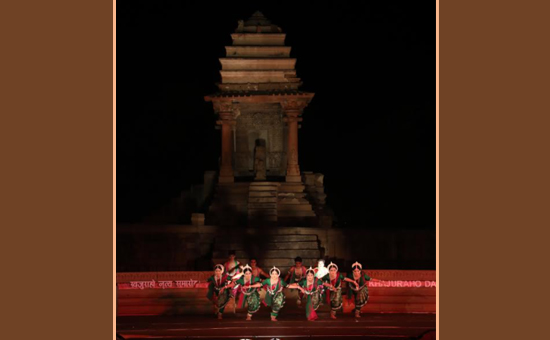 Ki Naad re performance.
Ki Naad re performance.
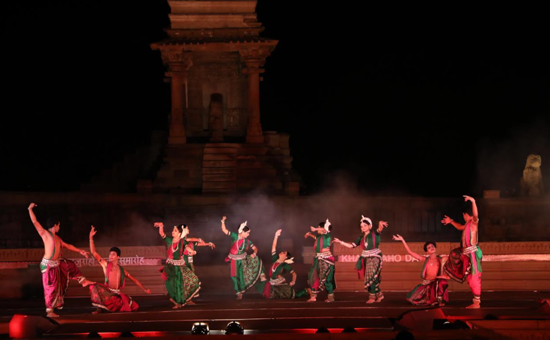 Nari Nirbhaya performance.
Nari Nirbhaya performance.